The Server Rack
Every nerd needs one!
The first PC

I started my pc collection with the fantastic Yosemite g3. At that point you could buy a g3 mac and later on replace the processor with a g4. I didn't know enough about PCs yet to realise that I should have gone for the g4 initially. I never did update the yosemite processor.
The first thing I did update was adding a second, larger hard disk. It didn't last long as the first generation motherboard had a faulty pata controller that corrupted the hard disks added. After that I was really backup-savvy.
The lanboy
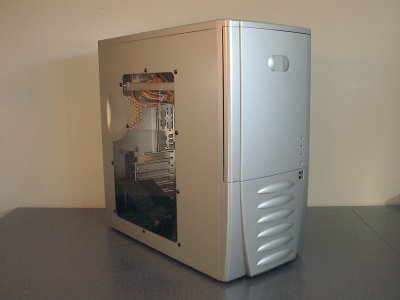
My second pc came years later when I had finished school, went through 2 years of intermittant employment and finally found a job in Brussels and moved to Leuven. That must have been around 2005 or 6. It was a AMD athlon something or other that I placed in a lightweight Antec Lanboy case for no other reason than that it looked cool. It was also noisy as hell, had led illuminated small fans behind a plexi window and was placed about 30cm away from the headend of my bed. The old yosemite and the new pc were stood next to eachother, and both in use.
The P180
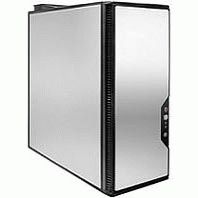
Later I moved to Brussels and at first both pc's lived on a furniture board with casters. Even the monitor was on the board which I moved from my bedroom to my living room as needed. This ended once I got steady with my SO, of course. I bought a cheap kvm and built a rack for both machines.
Now the rack could have held a 19" case in theory, but in practice it was wobbly as hell. This had to do with my clever swedish and Riteveldinfluenced design. Using only 2*4s made for a very loosely interconnected stand with a crappy workplace on top. When funds allowed I switched the pc switched to a 14kg Antec p180. I also switched to a 755 motherboard and a wimpy intel processor. I kept modding the P180 to make it more quiet, as it spent most of the nights rendering away in our bedroom. The unstable rack just made the sound worse.
The rack might have been unstable, but at one point I made things worse by adding a tiny pedeastal for my monitor that was a lot smaller than it's foot. About a week later my cats woke me up by jumping on my 19" Sony CRT monitor at 5 in the morning and letting the whole thing crash. Strapped for funds I went with a cheapass lcd replacement.
The ghetto nas
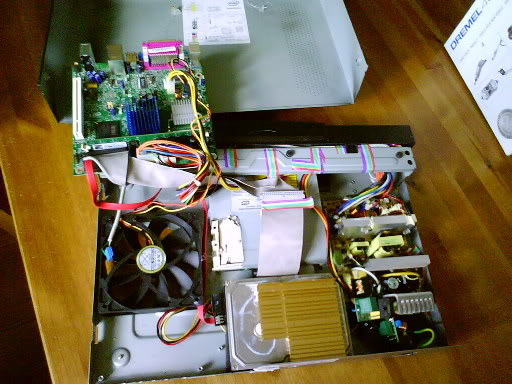
At this point, on account of my webdeveloper dreams having been crushed by reality, I got a job in IT at the European Parliament. One of my colleagues was also a bit of a cheapass pc afficionado, of the linux kind. So one day we set of to Leuven to pick up the first Atom motherboard.
I planned to use it as a downloading pc initially. My main reason was the electricity bill the main pc and the mac, used together while webdeveloping, but also while rendering my 3D hobbie movies, had racked up. The Atom was installed in the ghetto nas and served well from then on. Eventually the lanboy with it's amd mobo was shipped off to a friend who needed a pc.
The Data Problem
At one point I ran out of disk space in a most amusing fashion. At one point I'd decided to scan all of my CDroms, two shoeboxes full. At that point my rather crappy Asrock motherboard sata controller started corrupting the raid I'd been using. As my hard disk was full, and wary of being unbacked up, and the price of writeable dvds having dropped, I wrote all of that data back onto DVDs.
Now I had a single shoebox full of DVD, besides several of those plastic binders. My SO had made it clear that this was a ridiculous situation. I didn't trust any software raid anymore, and started looking for alternatives. I ended up with unraid.
As we were planning to move I'd been preparing a spreadsheet predicting our financial situation over the next few years. I had added one page with the stuff I'd like to buy, and the unraid went on it.
The Girlfriend PC
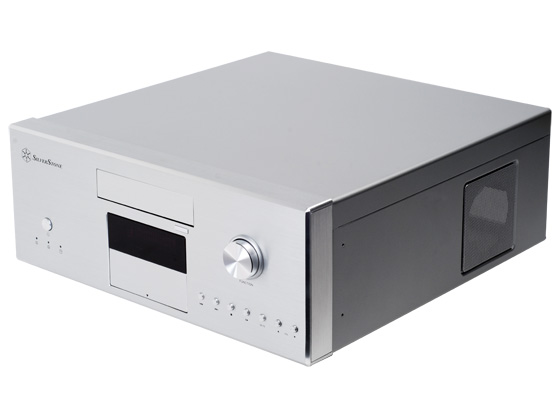
After I got my first indexation the money worked out and we moved to a place that was ideally located walking distance from both of our workplaces and had a garden and charm to boot.
As soon as we'd settled in, I went and ordered a Silverstone LC16s (for silver) that I told my SO would fit with the A/V amp I'd add later. I also got a mini-itx 775 mobo and upgraded my PC with a q6600 processor. My old dual core processor went into the new Pc, which I set up as a media pc for use by my SO, while I used my main box for serious stuff. The media pc was also used to download torrents, so I didn't have to run my heavier pc all the time.
The Unraid Box
But I was still concerned with my data safety. At this point all of my digital art took up 4 raid-1ed hard disks wich were in the bottom of my p82.
I hadn't had raid issues with my new motherboard, but the Unraid idea kept nagging me. When I'd bought the LC16s, I'd planned to put both the girlfriend PC and the unraid nas in it. But I couldn't work out how to do it, as I couldn't afford the shuttle-type PSUs and the modification required to add both motherboards and disks were complex to say the least.
Then one day the girlfriend PC helped out by dying. After testing everything- by then we had expanded the family with a little boy, and the time the testing took was frowned upon by my SO- I decided it was the mobo.
This freed up the LC16s for the Unraid server. I switched the atom board from the GhettoNAS, which had not been reused after the move, into the Silverstone and added a sata pci card for the unraid.
Then, carefully, I added one mirrored disk as the parity disk, another one as a data disk, and transfered my first data. After that I added the just emptied data disk, transfered the rest of the data, and added the last disk. From there I quickly reached the full 6 disk my license (and the case) allowed and went on to replace the 1tb disks with 2tb disks. Some of the 1tb disks later went on to be used in an Unraid nas I made for my brother- which also featured the mobo from the girlfriend PC.
The desk
At this point the Yosemite had long been banished to the basement (in disconnected state) and the wobbly homebuilt rack had been replaced by a desk. In true rompmeister fashion, the wood from the wobbly rack was set out on the terrace to weather. I wanted to make a coffee table out of it, which never happened. Let this be a lesson- leave the furniture planning to your SO.
So my P82 was under the desk, and on top of it stood the cable modem, my trusty WRT and the screen. Next to the desk stood the Ikea cabinet that had once sported the GhettoNas. It now carried the LC16s and my TX-SR606 receiver. The TX-SR606 fed images from the tv box and pc's to a projector. All of this, of course, was connected with loads of cable spaghetti. Every pc working and the projector cooling made enough noise to drown out dialogue on movies. And since offspring n.1 had been joined by offspring n.2 the whole thing was in constant danger of being dismantled. I wanted to go a step further.
OE TV box
>
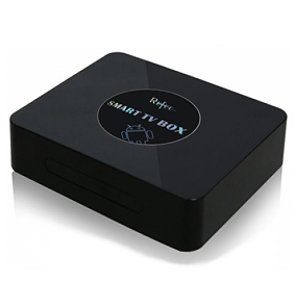
The first thing I wanted to do was get rid of the noise of my main PC and the Unraid box while watching movies. I could move them both to the basement, then run the required cabling torugh the floor or wall ducts. However I soon figured out that the cabling wouldn't be a sinecure. HDMI could carry far enough, but what about the dvi for my monitor, and the usb for keyboard and mouse? The kvm solutions I looked at were slow (in millisecond terms) and expensive.
The next idea was to at least replace my main pc when watching movies.
I had been looking at several XBMC based solutions since 2011. But the cheaper solutions were not performant enough. In the summer of 2012, amlogic m3 based solutions started sprouting like mushrooms. I'd been waiting for either someone to hack the apple TV3 or an android alternative. J1nx convinced me to buy the Oval Elephant tv box.
Even so the first attempts were less than satisfactory. It took J1nx releasing a linux XBMC for the box before it became reasonably useful.
Nas4free
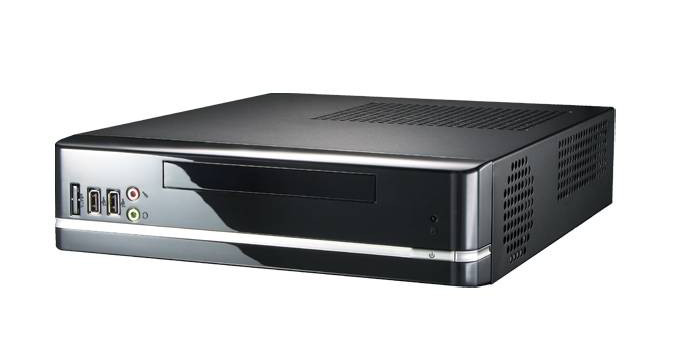
Meanwhile finances had improved and I'd set up another idea. This was to improve upon the GhettoNas. The GhettoNas had run windows XP. Now I wanted a better solution, and after a lot of searching came up with Nas4free.
My first attempt of setting up Nas4free failed because of the weird install method they use. Though it's not immediately clear from their website, you have to burn their installer to cd, then boot from this and install it on a usb stick.
Once I'd figured this out the Nas4free was literally set up in minutes.
The basement
And then, one day when my SO was out with n.1 and n.2 had gone to bed, I tested my my brand new setup-less bridge, drilled a hole in the floor, led my extra long cable to the basement, powered down the Unraid and the Nas4free, and carried everything down.
My SO had once found a little school desk for kids without top. I plunked the whole mess down on it, plugged them in (all bios were set to autostart on powerup) and went back upstairs. It was an awesome feeling as I tested the setup. From my phone I could now search for movies, download them on the Nas4free, and watch them on my TV box. It wasn't quite as worry-free as Netflix would be, but then Belgium's de facto cable and phone monopolies would never allow Netflix in. Another issue was the fact that I still needed to archive movies from the Nas4free box onto the Unraid server.
Getting serious.
Every time I went down into the basement though I could hear the PSU fans getting louder and louder. The servers did not like the dusty environment. For years already I'd been planning a real server rack. Since my basement is also my workshop, I'd long known that the rack would need an airfilter. I'd designed several instances of rack. Now it was time to execute the designs.
While refreshing my concept of the rack I came across this sterling example of how to build one. I decided to crib my measurements from there.
Onwards
more is coming... when I get round to doing it! On the todo list: mount an unraid share on the nas4free box. Build the server rack. Set the Yosemite for wakeonlan and install remote desktop, add it headless to the server rack.
